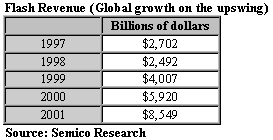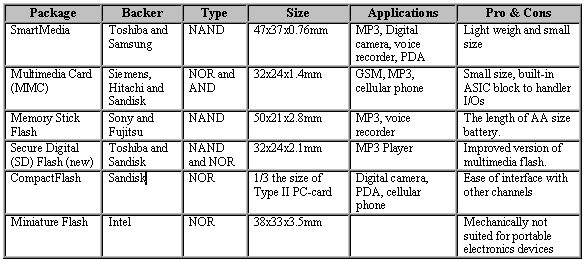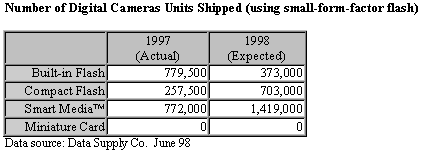|
 |
 |

 |
|
Flash Memory Defined
|
Wednesday, December 1, 1999
Flash solid-state-data storage retains data even when the power is off. Because of this, it is called the non-volatile memory. It functions much like the floppy disk drive. On the other hand, both DRAM and SRAM are volatile memories which require continuous power to retain data. Even though SRAM can have a built-in battery to keep the data alive and is super fast in data access, it is much too expensive when compared to flash. That is why flash memory is widely used in code and data storage applications. The chart below shows the estimated shipment of flash in the next few years.

Different Types of Flash Memories
Generally, there are four types of flash memories available in the market. They are slightly different from each other in the way the data is stored and accessed. The users normally select the type of flash based on these criteria: density, cost, reliability, operating voltage, memory performance, and most importantly its mechanical package.
NAND-based memories provide long block reads instead of random access across the device. They’re not as well suited for applications that require repetitive random accesses. But they are most suitable in applications that sequentially store data such as MP3 players, digital cameras, and disk-drive replacements. Toshiba and Samsung make NAND-based flash.
NOR cells operate in much the same way as EPROMs and ROMs, and permit random reads and writes. It is ideal for code storage applications such as PC Bios and Cellular phone. AMD and Intel sell NOR-based flash. Sandisk improved the NOR-based flash performance by incorporating their patented controller on the card. Sandisk’s improved technologies coupled with its industry standard package (CompactFlash) has made the NOR-based flash the popular choice for some data storage applications such as digital cameras.
DiNOR (Divided bit-line NOR) uses a special method to program or erase to prevent over-erasure and increase endurance. However, no technology other than NOR has been proven to be as reliable and durable in a high-volume manufacturing environment. Mitsubishi specializes in DiNOR flash.
AND structure offers both serial access to a sector and byte-addressed random access. It is good for mass-storage purposes. Hitachi makes AND-based flash memory.
Flash Package (Small-Form-Factor)
As portable consumer electronic devices such as cellular phones, MP3 players, digital cameras, PDAs and voice recorders grow in demand, manufacturers are gearing up to introduce different types of flash packaging in the hopes that it will become the next default standard in the industry. Here are a few of the contenders in the flash-card standards war.
SmartMedia – A current winner in the MP3 industry, SmartMedia provides portable device makers a lot of leverage in their design because of its small dimension. SmartMedia uses NAND based flash. It is mounted on a plastic carrier card that acts as a base for handling.
Multimedia Card (MMC) – The MMC format has a considerable combination of high scalability, small dimensions, and security features. It allows two stacked flash die in one MMC to increase the capacity. It features a high performance serial interface capable of performing reads at 20 Mbits per second and writes at 2 Mbits per second.
Memory Stick – The memory stick started to gain momentum and recognition as Sony pushed this format in its own audio and video applications. Sony claimed that some of its partners have already agreed to support this format in their applications. Among them are Aiwa, Casio Computer, Fujitsu, Olympus, Sanyo, and Sharp. The memory stick is longer in length compared to its counterparts.
Secure Digital Flash (SD) – SD is a new format created by Toshiba, Matsushita Electric, and Sandisk. SD includes a proprietary security function in both the hardware and software. This is a necessary feature when the music industry makes the contents accessible over the internet. It is compatible to the Multimedia Card but is considered a better option with the security feature. It also supports the stack memory format.
Compact Flash – Although it is widely used in many applications, the card is less likely to be used in popular consumer devices such as MP3 players and smaller cellular phones due to its weight and size. The 50-pin CF Card is able to interface with PCs, PDAs, and printers when used in conjunction with the industry standard 68-pin PC card. It has a built-in controller to patrol the flash chips.
Miniature card – The miniature card was defeated by rivals mainly because of its mechanical design. It is not suited for portable electronics devices. It uses a relatively large connector that takes up a considerable amount of space and requires users to partially rotate the card to secure the insertion. Nevertheless, Intel continues to use the Miniature Card as a vehicle to push its Multilevel-cell (MLC) flash devices.


Other Packages Besides Small-Form-Factor Flash
PCMCIA Flash (Linear or ATA Flash) – Type I, II, III PC card
Linear flash memory stores and sends data in a linear fashion. Because the computer receives data in blocks, the linear data must first be translated into blocks of data. This is achieved by the Flash File System (FFS) or Flash Translation Layer (FTL) software. NOR-based flash is generally used in a linear PC card.
ATA Flash memory architecture places a micro-controller circuit on the card to handle the special write and erase algorithms required by Flash chips. To the operating system, the card resembles an IDE hard drive, so there are no compatibility issues. Sandisk dominates this market.
Memory SIMM/DIMM – This includes the 68pin, 80pin, 100pin, 144pin, and 168pin proprietary flash memories. The typical uses are in laser printers, copy machines, routers, ATM machines, credit card verification systems, etc. Most flash modules use NOR-based memory for code storage.
Flash Manufacturers
NOR: Intel, AMD, Macronix, Atmel, Sandisk
NAND: Toshiba, Samsung, Fujitsu
AND/DINOR: Hitachi, Mitsubishi
Others semiconductor manufacturers are hopping in the flash production bandwagon to take advantage of the surging demand, tight capacity, and soaring prices in flash market. While the race is on, only Intel’s Strataflash and Sandisk’s D2 multilevel storage technologies provide a promising solution to increase the density with less cost. In the meantime, Sandisk is working with Toshiba to incorporate its double-bit per cell technology onto Toshiba’s NAND-based flash.
Summary
With the growing demand for cellular phones, digital cameras, and MP3 players, the small-form-factor flash memory will surge in shipping volume over the next few years. The technology advancements such as die shrinkage, multilevel storage architectures, and better software controllers will push the common flash density from 32MB to 128MB and 256MB. It is unlikely that one common standard will dominate the flash market. Thus, watch out when you buy the portable electronics devices. Be sure you know what type of memory is used inside.
By: Daniel
Copyright © 2023 CST, Inc. All Rights Reserved
|
 |
 |
|


